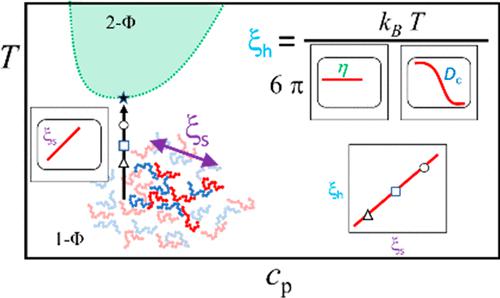当前位置:
X-MOL 学术
›
ACS Macro Lett.
›
论文详情
Our official English website, www.x-mol.net, welcomes your
feedback! (Note: you will need to create a separate account there.)
Applicability of the Generalized Stokes–Einstein Equation of Mode-Coupling Theory to Near-Critical Polyelectrolyte Complex Solutions
ACS Macro Letters ( IF 5.1 ) Pub Date : 2023-02-10 , DOI: 10.1021/acsmacrolett.2c00647 Yuanchi Ma 1 , Steven D Hudson 1 , Paul F Salipante 1 , Jack F Douglas 1 , Vivek M Prabhu 1
ACS Macro Letters ( IF 5.1 ) Pub Date : 2023-02-10 , DOI: 10.1021/acsmacrolett.2c00647 Yuanchi Ma 1 , Steven D Hudson 1 , Paul F Salipante 1 , Jack F Douglas 1 , Vivek M Prabhu 1
Affiliation

|
We examine whether the mode-coupling theory of Kawasaki and Ferrell (KF) [Kawasaki, K. Kinetic Equations and Time Correlation Functions of Critical Fluctuations. Ann. Phys. 1970, 61 (1), 1–56; Ferrell, R. A. Decoupled-Mode Dynamical Scaling Theory of the Binary-Liquid Phase
Transition. Phys. Rev. Lett. 1970, 24 (21), 1169–1172] can describe dynamic light scattering (DLS) measurements of the dynamic structure factor of near-critical polyelectrolyte complex (PC) solutions that have been previously shown to exhibit a theoretically unanticipated lower critical solution temperature type phase behavior, i.e., phase separation upon heating, and a conventional pattern of static critical properties (low angle scattering intensity and static correlation, ξs) as a function of reduced temperature. Good qualitative accord is observed between our DLS measurements and the KF theory. In particular, we observe that the collective diffusion coefficient Dc of the PC solutions obeys the generalized Stokes–Einstein equation (GSE), Dc = kBT/6πηξs, where ξs is specified from our previous measurements and where η is measured by capillary rheometry under the same thermodynamic conditions as in our previous study of these solutions, allowing for a no-free-parameter test of the GSE. We also find that even the wavevector (q)-dependent collective diffusion coefficient Dc(q), measured by varying the scattering angle in the DLS measurements over a large range, is also well-described by the mean-field version of the KF theory. We find it remarkable that the KF theory provides such a robust description of collective diffusion in these complex charged polyelectrolyte blends under near-critical conditions given that charge fluctuations and association of the polymers might be expected to lead to physical complications that would invalidate the standard model of uncharged fluid mixtures.
中文翻译:

模式耦合理论的广义斯托克斯 - 爱因斯坦方程对近临界聚电解质复杂溶液的适用性
我们检验了 Kawasaki 和 Ferrell (KF) 的模式耦合理论 [Kawasaki, K. 临界波动的动力学方程和时间相关函数。安。物理。 1970 , 61 (1), 1–56; Ferrell, RA 二元液相变的解耦模式动态标度理论。物理。牧师莱特。 1970 , 24(21), 1169–1172] 可以描述近临界聚电解质复合物 (PC) 溶液的动态结构因子的动态光散射 (DLS) 测量,这些溶液先前已被证明表现出理论上未预料到的较低临界溶液温度类型的相行为,即,加热时的相分离,以及作为降低温度函数的静态临界特性(低角散射强度和静态相关性, ξ s )的常规模式。在我们的 DLS 测量和 KF 理论之间观察到良好的定性一致性。特别地,我们观察到PC 解的集体扩散系数D c服从广义斯托克斯-爱因斯坦方程 (GSE), D c =k B T /6π ηξ s,其中ξ s是根据我们之前的测量指定的,其中 η 是在与我们之前对这些溶液的研究相同的热力学条件下通过毛细管流变测量法测量的,允许对这些溶液进行无自由参数测试GSE。我们还发现,即使是波矢量 ( q ) 相关的集体扩散系数D c ( q),通过在大范围内改变 DLS 测量中的散射角来测量,也由 KF 理论的平均场版本很好地描述。我们发现 KF 理论对这些复杂的带电聚电解质混合物在近临界条件下的集体扩散提供了如此有力的描述,这是值得注意的,因为电荷波动和聚合物的结合可能会导致物理并发症,从而使标准模型无效不带电的流体混合物。
更新日期:2023-02-10
中文翻译:

模式耦合理论的广义斯托克斯 - 爱因斯坦方程对近临界聚电解质复杂溶液的适用性
我们检验了 Kawasaki 和 Ferrell (KF) 的模式耦合理论 [Kawasaki, K. 临界波动的动力学方程和时间相关函数。安。物理。 1970 , 61 (1), 1–56; Ferrell, RA 二元液相变的解耦模式动态标度理论。物理。牧师莱特。 1970 , 24(21), 1169–1172] 可以描述近临界聚电解质复合物 (PC) 溶液的动态结构因子的动态光散射 (DLS) 测量,这些溶液先前已被证明表现出理论上未预料到的较低临界溶液温度类型的相行为,即,加热时的相分离,以及作为降低温度函数的静态临界特性(低角散射强度和静态相关性, ξ s )的常规模式。在我们的 DLS 测量和 KF 理论之间观察到良好的定性一致性。特别地,我们观察到PC 解的集体扩散系数D c服从广义斯托克斯-爱因斯坦方程 (GSE), D c =k B T /6π ηξ s,其中ξ s是根据我们之前的测量指定的,其中 η 是在与我们之前对这些溶液的研究相同的热力学条件下通过毛细管流变测量法测量的,允许对这些溶液进行无自由参数测试GSE。我们还发现,即使是波矢量 ( q ) 相关的集体扩散系数D c ( q),通过在大范围内改变 DLS 测量中的散射角来测量,也由 KF 理论的平均场版本很好地描述。我们发现 KF 理论对这些复杂的带电聚电解质混合物在近临界条件下的集体扩散提供了如此有力的描述,这是值得注意的,因为电荷波动和聚合物的结合可能会导致物理并发症,从而使标准模型无效不带电的流体混合物。




















































 京公网安备 11010802027423号
京公网安备 11010802027423号